A Study on the Spatial Pattern of the Ecological Product Value of China’s County-Level Regions Based on GEP Evaluation
Abstract
:1. Introduction
2. Materials and Methods
2.1. Scope of the Study
2.2. Research Methodology
2.2.1. Overview of Research Methods
2.2.2. GEP Evaluation
2.2.3. Analysis of Results
2.2.4. Overall Technology Roadmap
2.3. Data Sources
3. Results
3.1. Provisioning Service Index
3.2. Regulating Service Index
3.3. Cultural Service Index
3.4. Composite GEP Index
4. Discussion
5. Conclusions
Author Contributions
Funding
Institutional Review Board Statement
Informed Consent Statement
Data Availability Statement
Acknowledgments
Conflicts of Interest
References
- Hein, L.; Van Koppen, K.; De Groot, R.S.; Van Ierland, E.C. Spatial scales, stakeholders and the valuation of ecosystem services. Ecol. Econ. 2006, 57, 209–228. [Google Scholar] [CrossRef]
- Chee, Y.E. An ecological perspective on the valuation of ecosystem services. Biol. Conserv. 2004, 120, 549–565. [Google Scholar] [CrossRef]
- Seppelt, R.; Dormann, C.F.; Eppink, F.V.; Lautenbach, S.; Schmidt, S. A quantitative review of ecosystem service studies: Approaches, shortcomings and the road ahead. J. Appl. Ecol. 2011, 48, 630–636. [Google Scholar] [CrossRef]
- Han, Z.L.; Zhao, Y.Q.; Yan, X.L.; Zhong, J.Q. Coupling Coordination Mechanism and Spatial-Temporal Relationship between Gross Ecosystem Product and Regional Economy: A Case Study of Dalian. Econ. Geogr. 2020, 40, 1–10. [Google Scholar]
- Hein, L.; Bagstad, K.J.; Obst, C.; Edens, B.; Schenau, S.; Castillo, G.; Soulard, F.; Brown, C.; Driver, A.; Bordt, M.; et al. Progress in natural capital accounting for ecosystems. Science 2020, 367, 514–515. [Google Scholar] [CrossRef]
- UN. The System of National Accounts; UN: New York, NY, USA, 2008. [Google Scholar]
- Daily, G.C. Services: Societal Dependence on Natural Ecosystems; Island Press: Washington, DC, USA, 1997. [Google Scholar]
- Costanza, R.; d’Arge, R.; De Groot, R.; Farber, S.; Grasso, M.; Hannon, B.; Limburg, K.; Naeem, S.; O’neill, R.V.; Paruelo, J.; et al. The value of the world’s ecosystem services and natural capital. Nature 1997, 387, 253–260. [Google Scholar] [CrossRef]
- OuYang, Z.Y.; Wang, X.K.; Miao, H. A primary study on Chinese terrestrial ecosystem services and their ecological-economic values. Acta Ecol. Sin. 1999, 5, 19–25. [Google Scholar]
- Howarth, R.B.; Farber, S. Accounting for the value of ecosystem services. Ecol. Econ. 2002, 41, 421–429. [Google Scholar]
- Chen, Z.; Zhang, X. Value of ecosystem services in China. Chin. Sci. Bull. 2000, 45, 870–876. [Google Scholar] [CrossRef]
- Jin, D.; Watson, C.; Kite-Powell, H.; Kirshen, P. Evaluating Boston Harbor cleanup: An ecosystem valuation approach. Front. Mar. Sci. 2018, 5, 478. [Google Scholar] [CrossRef]
- Escobedo, F.J.; Giannico, V.; Jim, C.Y.; Sanesi, G.; Lafortezza, R. Urban forests, ecosystem services, green infrastructure and nature-based solutions: Nexus or evolving metaphors? Urban For. Urban Green. 2019, 37, 3–12. [Google Scholar] [CrossRef]
- Raum, S.; Hand, K.L.; Hall, C.; Edwards, D.M.; O’Brien, L.; Doick, K.J. Achieving impact from ecosystem assessment and valuation of urban greenspace: The case of i-Tree Eco in Great Britain. Landsc. Urban Plan. 2019, 190, 103590. [Google Scholar] [CrossRef]
- Bateman, I.J.; Harwood, A.R.; Abson, D.J.; Andrews, B.; Crowe, A.; Dugdale, S.; Fezzi, C.; Foden, J.; Hadley, D.; Haines-Young, R.; et al. Economic Analysis for the UK National Ecosystem Assessment: Synthesis and Scenario Valuation of Changes in Ecosystem Services. Environ. Resour. Econ. 2014, 57, 273–297. [Google Scholar] [CrossRef]
- Raymond, C.M.; Bryan, B.A.; MacDonald, D.H.; Cast, A.; Strathearn, S.; Grandgirard, A.; Kalivas, T. Mapping community values for natural capital and ecosystem services. Ecol. Econ. 2009, 68, 1301–1315. [Google Scholar] [CrossRef]
- Sannigrahi, S.; Pilla, F.; Basu, B.; Basu, A.S.; Zhang, Q.; Wang, Y.; Joshi, P.K.; Chakraborti, S.; Coscieme, L.; Keesstra, S.; et al. Identification of conservation priority zones using spatially explicit valued ecosystem services: A case from the Indian Sundarbans. Conservation priority zones using spatially explicit valued ecosystem services: A case from the Indian Sundarbans. Assess. Manag. 2020, 16, 773–787. [Google Scholar]
- Yu, F.; Yang, W.S.; Ma, G.X.; Zhou, Y. The latest development and prospect of ecological value accounting at home and abroad. Environ. Prot. 2020, 48, 18–24. [Google Scholar]
- UN. The System of Environmental-Economic Accounting; UN: New York, NY, USA, 2014. [Google Scholar]
- Ouyang, Z.Y.; Zhu, C.Q.; Yang, G.B.; Xu, W.H.; Zheng, H.; Zhang, Y.; Xiao, Y. Gross ecosystem product: Concept, accounting framework and case study. Acta Ecol. Sin. 2013, 33, 6747–6761. [Google Scholar] [CrossRef]
- Ma, G.X.; Yu, F.; Wang, J.N.; Zhou, X.F.; Yuan, J.; Mu, X.J.; Zhou, Y.; Yang, W.S.; Peng, F. Measuring gross ecosystem product (GEP) of 2015 for terrestrial ecosystems in China. China Environ. Sci. 2017, 37, 1474–1482. [Google Scholar]
- Ouyang, Z.Y. Theory and Methods of Gross Ecosystem Product (GEP) Accounting; Science Press: Beijing, China, 2021. [Google Scholar]
- Bai, Y.; Li, H.; Wang, X.Y.; Alatalo, J.M.; Liu, W.J. Evaluating natural resource assets and gross ecosystem products using ecological accounting system: A case study in Yunnan Province. J. Nat. Resour. 2017, 32, 1100–1112. [Google Scholar]
- Xie, H.; Li, Z.; Xu, Y. Study on the coupling and coordination relationship between gross ecosystem product (GEP) and regional economic system: A case study of Jiangxi Province. Land 2022, 11, 1540. [Google Scholar] [CrossRef]
- Guan, S.; Liao, Q.; Wu, W.; Yi, C.; Gao, Y. Revealing the coupling relationship between the gross ecosystem product and economic growth: A case study of Hubei Province. Sustainability 2022, 14, 7546. [Google Scholar] [CrossRef]
- Jin, D.; Bian, Z.F. The Accounting of Ecological Civilization in Xuzhou based on emergy and gross ecosystem production. China Land Sci. 2013, 27, 88–94. [Google Scholar]
- Ouyang, Z.Y.; Lin, Y.Q.; Song, C.S. Research on gross ecosystem product (GEP): Case study of Lishui City, Zhejiang Province. Sustain. Dev. 2020, 45, 80–85. [Google Scholar]
- Niu, L.; Wang, J.Y.; Xi, F.M.; Yin, Y.; Bing, L.F.; Ma, M.J.; Zhang, W.F. Gross economic-ecological product accounting of Fuzhou City, China. Chin. J. Appl. Ecol. 2021, 32, 3793–3804. [Google Scholar]
- Mou, X.J.; Rao, S.; Jiang, H.Q.; Wang, X.H.; Zhang, X.; Wu, W.J.; Lu, Y.L.; Duan, Y. Research on ecological and environment (Green GDP) accounting in Yanqing district, Beijing. Environ. Ecol. 2019, 1, 1–9. [Google Scholar]
- Dolkar, P.; Xiao, Y.; Ouyang, Z.Y.; Wang, L.Y. Assessment of ecological conservation effect in Xishui county based on gross ecosystem product. Acta Ecol. Sin. 2020, 40, 499–509. [Google Scholar]
- You, X.; He, D.J.; Xiao, Y.; Wang, L.Y.; Song, C.S.; Ouyang, Z.Y. Assessment of ecological protection effectiveness in a county area: Using Eshan County. Acta Ecol. Sin. 2019, 39, 3051–3061. [Google Scholar]
- Chen, M.; Ji, R.T.; Liu, C.W.; Su, L.H.; Zhang, L.J. Gross ecosystem product accounting for ‘Two Mountains’ bases and transformation analysis: The case study of Ninghai County. Acta Ecol. Sin. 2021, 41, 5899–5907. [Google Scholar]
- Wei, X.X.; Zhao, J.; Wei, W.; Xie, B.B. Spatial and temporal changes of ecological vulnerability per county unit in China. Acta Sci. Circumstantiae 2016, 36, 726–739. [Google Scholar]
- Li, T.; Chen, T.Y.; Hui, B.H. Economic value of forest ecosystem services in Huangshan City based on Meta-analysis. Sci. Geogr. Sin. 2022, 42, 2179–2188. [Google Scholar]
- Kout, S.; Ala, A.; Belahmadi MS, O.; Hassaine, A.; Bordjiba, O.; Tahar, A. Ecological products value realization mechanism and effectiveness evaluation in the Yangtze River Basin. J. Environ. Eng. Technol. 2022, 12, 399–407. [Google Scholar]
- Yang, X.M.; Yin, C.B. The Concept Connotation and Value Realization Pathway of Agro-ecological Products. Chin. J. Agric. Resour. Reg. Plan. 2022, 43, 39–45. [Google Scholar]
- Xu, X.J.; Wang, Y.Y. An Empirical Test of the Dynamic Relationship between Tourism Development and Economic Growth in Yunnan Province. Stat. Decis. 2023, 1, 126–130. [Google Scholar]
- Chen, X.L. The origin, development and propspect of non-timber forest-based economics. J. Nanjing For. Univ. 2022, 46, 105–114. [Google Scholar]
- Du, W.W.; Qin, L.M.; Wu, Y.H.; Yu, J. Improving Forest Ecosystem Services Under Park City Concept. Landsc. Archit. 2020, 27, 43–50. [Google Scholar]
- Dong, X.; Liu, P. Impacts study of GEE-based land use changes on Ecosystem Service Value(ESV): Take the Beijing-Tianj in-Hebei Region as an example. J. Cent. China Norm. Univ. 2020, 54, 670–678. [Google Scholar]
- Wang, D.C.; Sun, Z.C.; Sun, R.H.; Chen, J.H.; Zhang, W.; Zhang, X.; Wang, X. Spatial-temporal dynamic evolution of ecosystem service value in Beijing-Tianjin-Hebei urban agglomeration. Ecol. Environ. Sci. 2019, 28, 1285–1296. [Google Scholar]
- Tang, X.M.; Liu, Y.; Ren, Y.M.; Zhou, Y.B. Evaluation and analysis of ecosystem services value in Beijing-Tianjin-Hebei region based on demand zoning. Acta Sci. Nat. Univ. Pekin. 2021, 57, 173–180. [Google Scholar]
- Zheng, Z.H.; Wu, Z.F.; Chen, Y.B.; Yang, Z.W.; Francesco, M. Analyzing the ecological environment and urbanization characteristics of the Yangtze River Delta Urban Agglomeration based on Google Earth Engine. Acta Ecol. Sin. 2021, 41, 717–729. [Google Scholar]
- Qi, A.X.; Yang, Q.Y.; Bi, G.H.; Li, J.X. A comparative study on coordinated development of social economy and ecological environment of urban agglomeration—An empirical study on three urban agglomerations in China. J. Southwest China Norm. Univ. 2018, 43, 75–84. [Google Scholar]
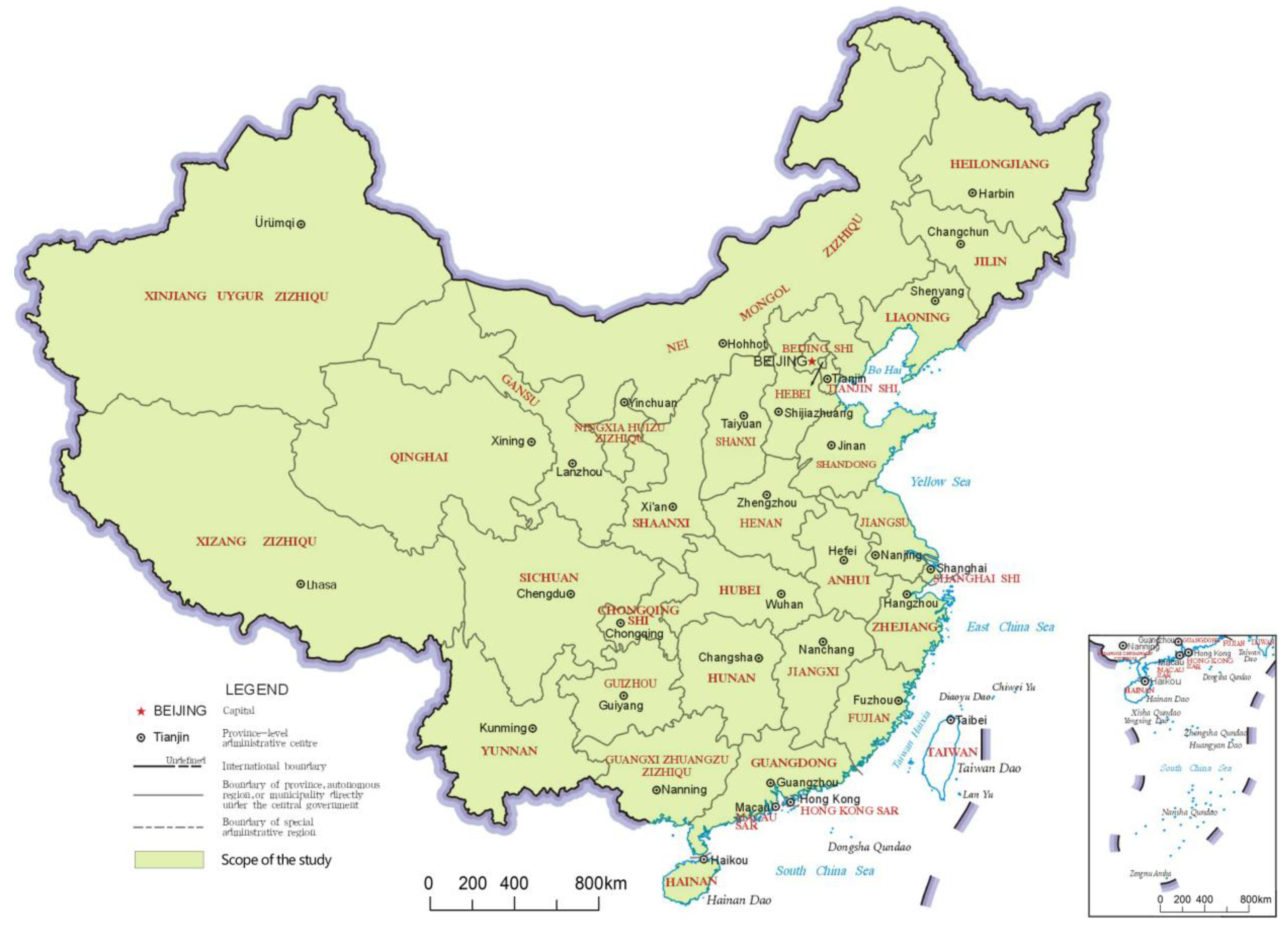
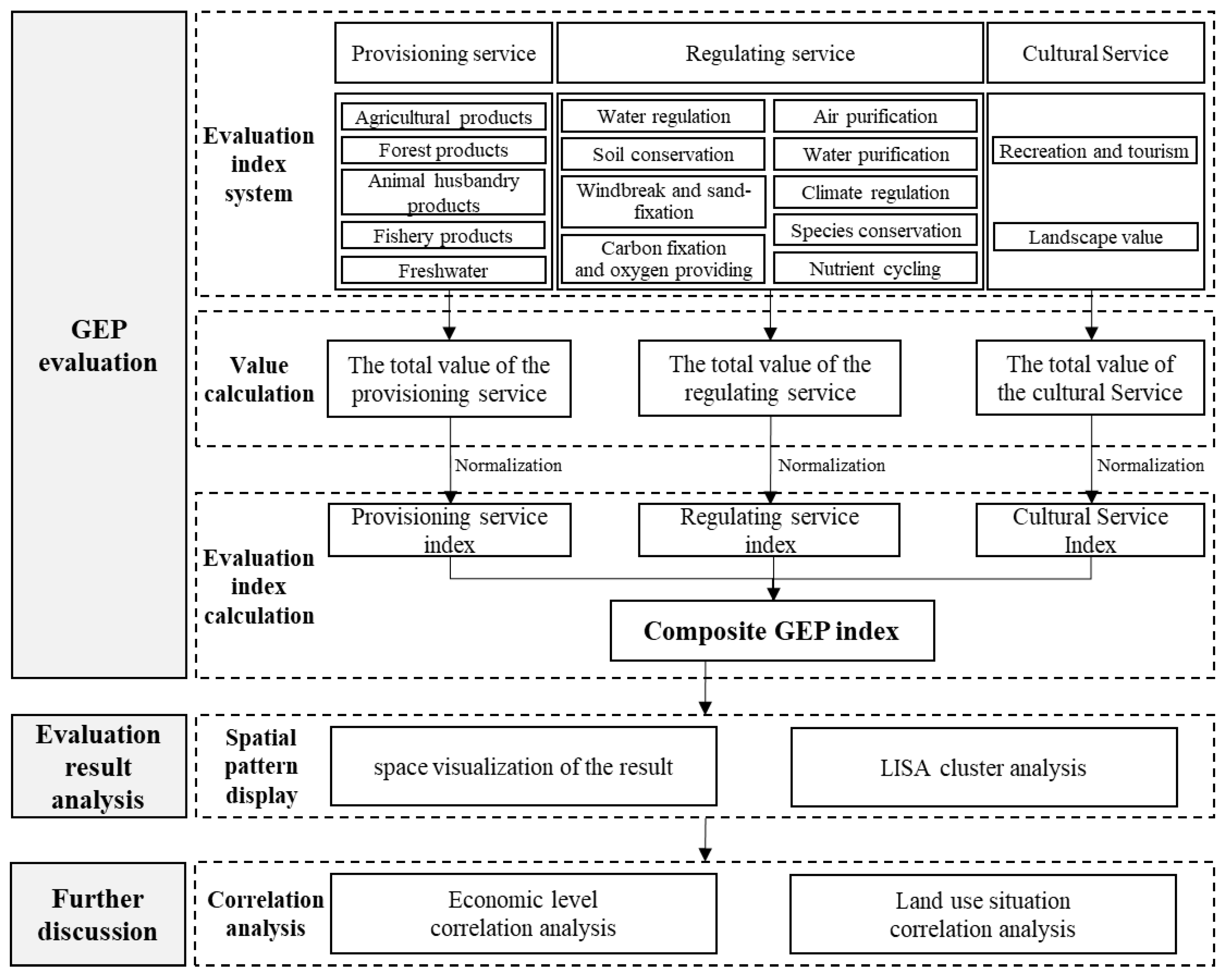

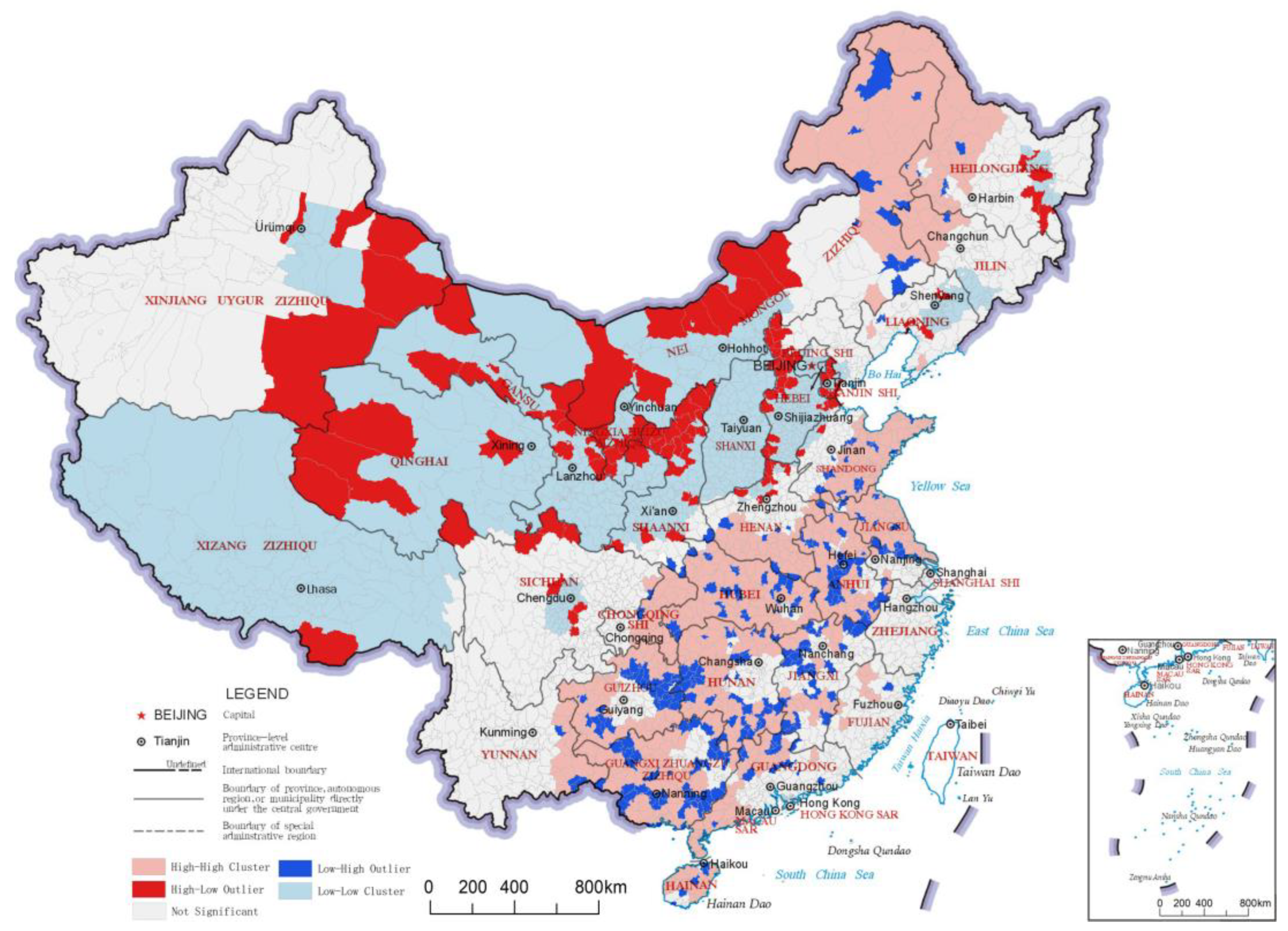
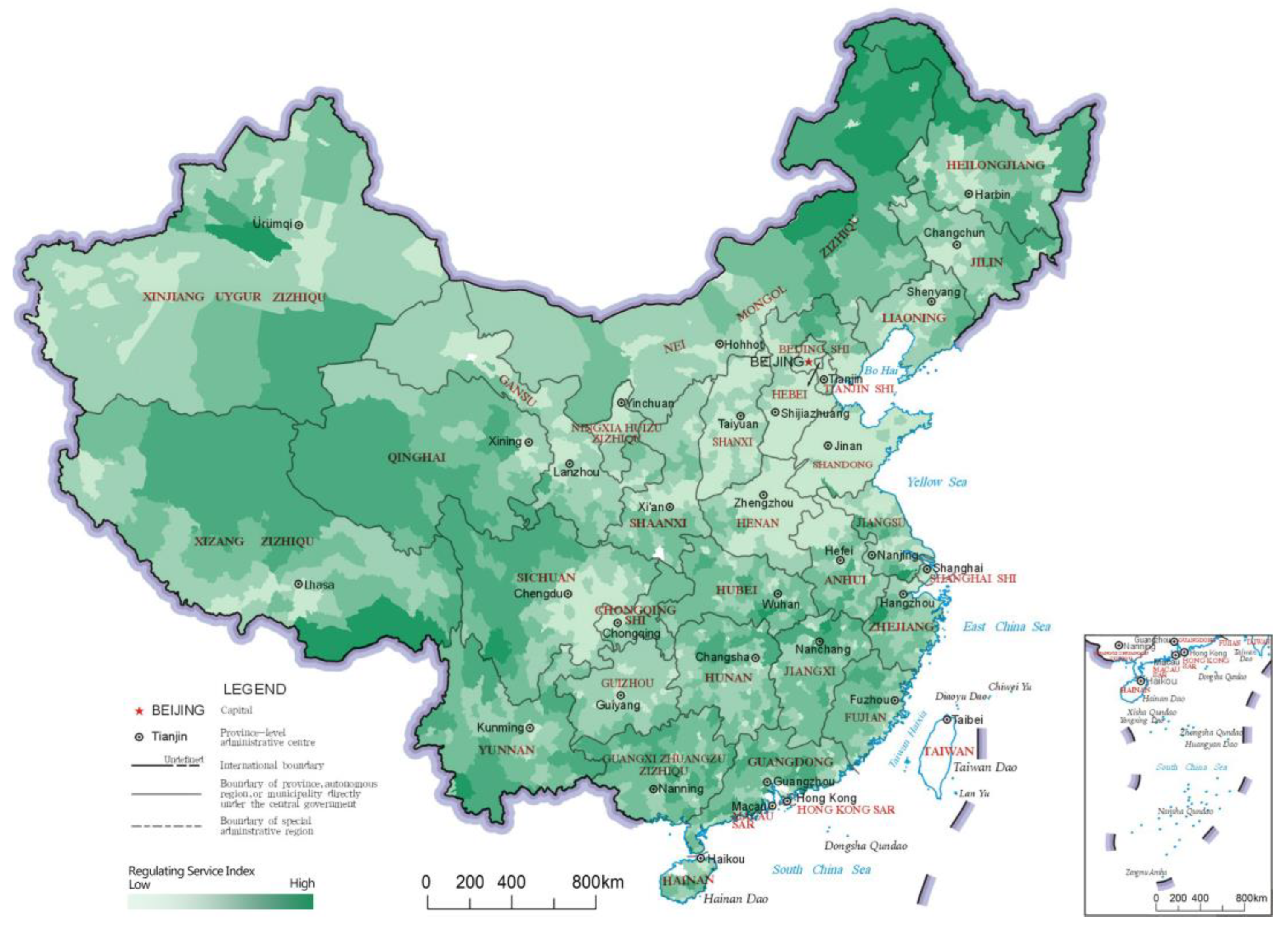



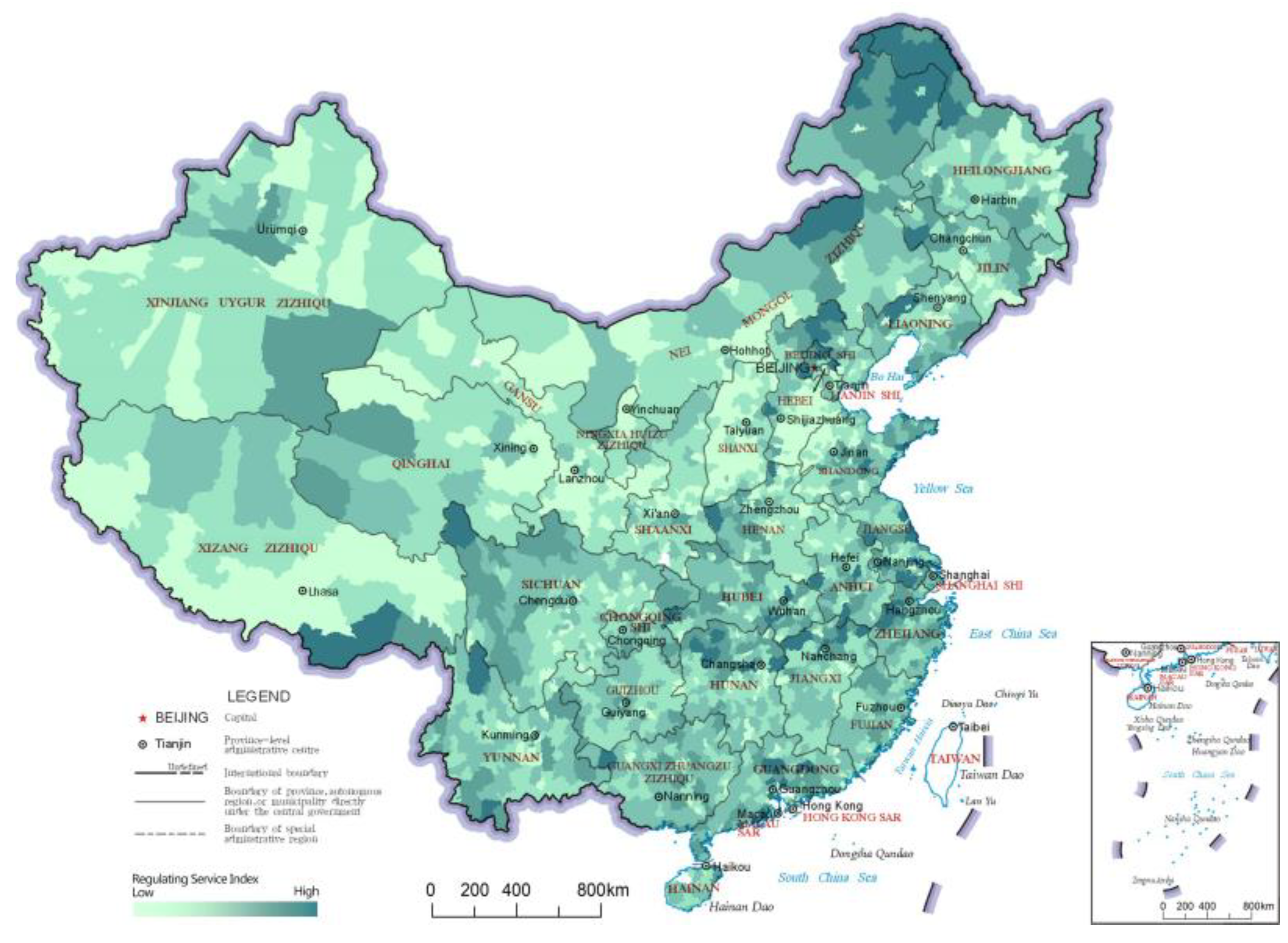
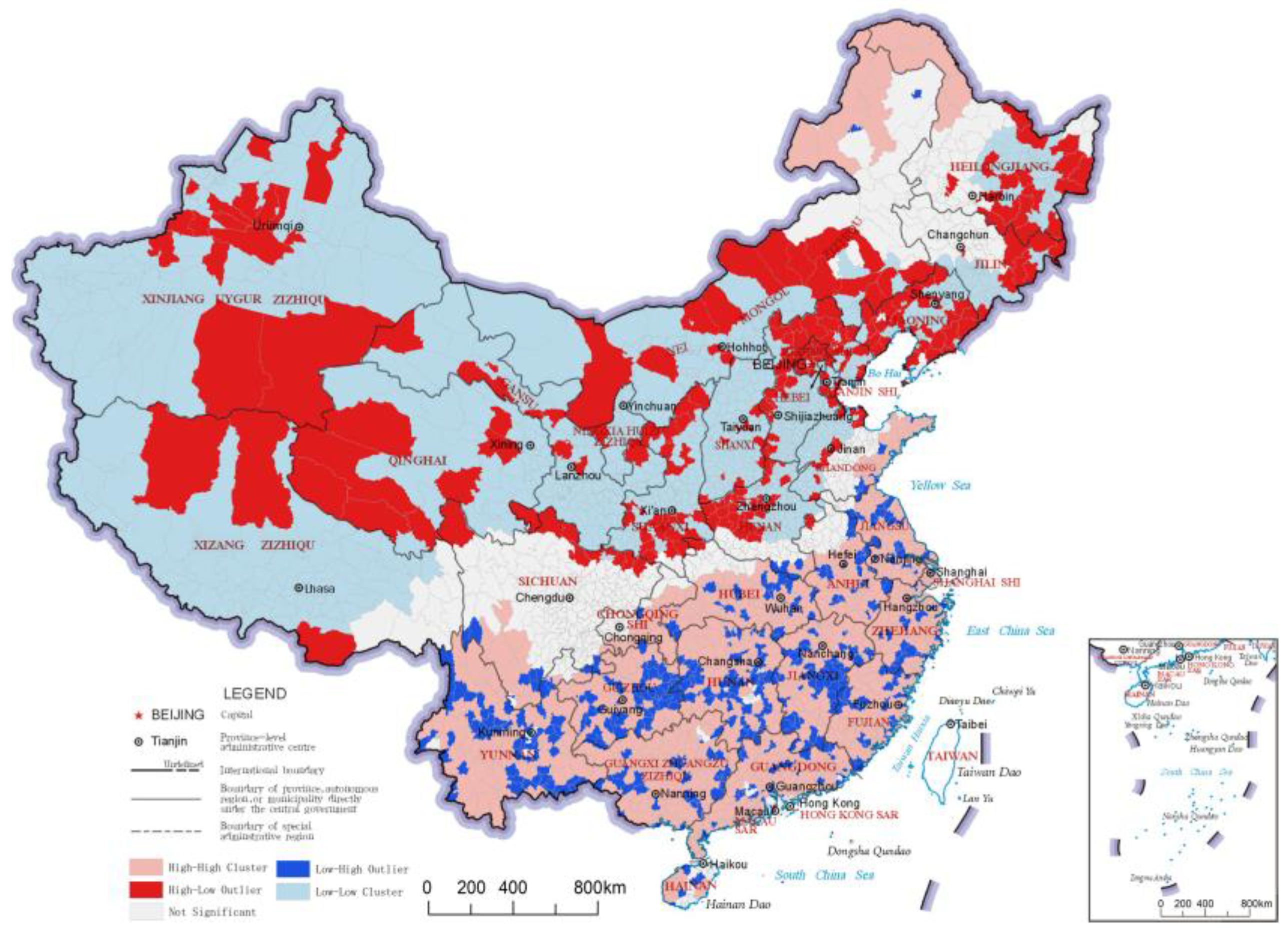
| Ecosystem Services | United Nations Millennium Ecosystem Assessment (MA) | European Union The Economics of Ecosystems and Biodiversity (TEEB) | United Nations Experimental Ecosystem Accounting (EEA) | Technical Guide for Gross Terrestrial Ecosystem Product (GEP) Calculation |
|---|---|---|---|---|
| Provisioning services | Food Fresh water Fuelwood Fibre Biochemicals Genetic resources | Food Water Raw materials Genetic resources Medicinal resources Ornamental resources | Water Materials Energy Other provisioning services | Agricultural products Forest products Animal husbandry products Fishery products Ecological energy Others |
| Regulating services | Climate regulation Disease regulation Water regulation Water purification | Air purification Climate regulation Disturbance prevention or moderation Regulation of water flows Waste treatment Erosion prevention Maintaining soil fertility Pollination Biological control | Remediation and regulation of biophysical environment Flow regulation Regulation of physicochemical environment Regulation of biotic environment | Water conservation Soil conservation Windbreak and sand-fixation Coastal zone protection Flood water storage Carbon fixation Oxygen providing Air purification Water purification Pollination Climate regulation Species conservation |
| Cultural services | Spiritual and religious Recreation and ecotourism Aesthetic Inspirational Educational Sense of place Cultural heritage | Aesthetic information Recreation and tourism Inspiration for culture, art and design Spiritual experience Information for cognitive development | Physical or experiential use of ecosystems Intellectual representations of ecosystems | Recreation and tourism Landscape value |
| Supporting services | Soil formation Nutrient cycling Primary production | Lifecycle maintenance Gene pool protection | / | / |
| Classification | Elements | Provisioning Service Index | Regulating Service Index | Cultural Service Index | Composite GEP Index |
|---|---|---|---|---|---|
| Economic level | GDP | −0.015 | −0.133 **,1 | 0.394 ** | 0.196 ** |
| Land use situation | Proportion of water area | 0.109 ** | 0.092 ** | 0.217 ** | 0.223 ** |
| Proportion of woodland area | 0.104 ** | 0.404 ** | 0.121 ** | 0.262 ** | |
| Proportion of grassland area | −0.025 | 0.181 ** | −0.199 ** | −0.078 ** | |
| Proportion of artificial surface area | −0.302 ** | −0.397 ** | 0.143 ** | −0.196 ** | |
| Proportion of wetland area | 0.086 ** | 0.067 ** | −0.036 | 0.044 * | |
| Proportion of bare land area | −0.043 * | 0.006 | −0.139 ** | −0.107 ** | |
| Proportion of shrubland | −0.007 | 0.069 ** | 0.010 | 0.025 | |
| Proportion of arable land area | 0.115 ** | −0.345 ** | −0.052 ** | −0.086 ** | |
| Proportion of glacier area | −0.049 ** | 0.086 ** | −0.083 ** | −0.049 ** |
Disclaimer/Publisher’s Note: The statements, opinions and data contained in all publications are solely those of the individual author(s) and contributor(s) and not of MDPI and/or the editor(s). MDPI and/or the editor(s) disclaim responsibility for any injury to people or property resulting from any ideas, methods, instructions or products referred to in the content. |
© 2023 by the authors. Licensee MDPI, Basel, Switzerland. This article is an open access article distributed under the terms and conditions of the Creative Commons Attribution (CC BY) license (https://creativecommons.org/licenses/by/4.0/).
Share and Cite
Shen, P.; Wu, L.; Huo, Z.; Zhang, J. A Study on the Spatial Pattern of the Ecological Product Value of China’s County-Level Regions Based on GEP Evaluation. Int. J. Environ. Res. Public Health 2023, 20, 3181. https://doi.org/10.3390/ijerph20043181
Shen P, Wu L, Huo Z, Zhang J. A Study on the Spatial Pattern of the Ecological Product Value of China’s County-Level Regions Based on GEP Evaluation. International Journal of Environmental Research and Public Health. 2023; 20(4):3181. https://doi.org/10.3390/ijerph20043181
Chicago/Turabian StyleShen, Ping, Lijuan Wu, Ziwen Huo, and Jiaying Zhang. 2023. "A Study on the Spatial Pattern of the Ecological Product Value of China’s County-Level Regions Based on GEP Evaluation" International Journal of Environmental Research and Public Health 20, no. 4: 3181. https://doi.org/10.3390/ijerph20043181
APA StyleShen, P., Wu, L., Huo, Z., & Zhang, J. (2023). A Study on the Spatial Pattern of the Ecological Product Value of China’s County-Level Regions Based on GEP Evaluation. International Journal of Environmental Research and Public Health, 20(4), 3181. https://doi.org/10.3390/ijerph20043181




